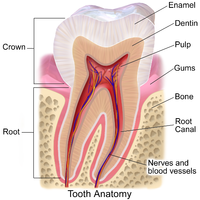
Photo from wikipedia
BACKGROUND Cortico-cortical evoked potentials (CCEP) are a technique using low frequency stimulation to infer regions of cortical connectivity in patients undergoing Stereo-electroencephalographic (SEEG) monitoring for refractory epilepsy. Little attention has… Click to show full abstract
BACKGROUND Cortico-cortical evoked potentials (CCEP) are a technique using low frequency stimulation to infer regions of cortical connectivity in patients undergoing Stereo-electroencephalographic (SEEG) monitoring for refractory epilepsy. Little attention has been given to volume conducted components of CCEP responses, and how they may inflate CCEP connectivity. NEW METHOD Using data from 37 SEEG-CCEPs patients, a novel method was developed to quantify stimulation artefact by measuring the peak-to-peak voltage difference in the first 10 ms after CCEP stimulation. Early responses to CCEP stimulation were also quantified by calculating the root mean square of the 10-100 ms period after each stimulation pulse. Both the early CCEP responses and amplitude of stimulation artefact were regressed by physical distance, stimulation waveform, stimulation intensity and tissue type to identify conduction related properties. RESULTS Both stimulation artefact and early responses were correlated strongly with the inverse square of the distance from the stimulating electrode. Once corrected for the inverse square distance from the electrode, stimulation artefact and CCEP responses showed a linear relationship, indicating a volume conducted component. COMPARISON WITH EXISTING METHODS This is the first study to use stimulation artefact to quantify volume conducted potentials, and is the first to quantify volume conducted potentials in SEEG. A single prior study utilizing electrocorticography has shown that parts of early CCEP responses are due to volume conduction. CONCLUSIONS The linear relationship between stimulation artefact amplitude and CCEP early responses, once corrected for distance, suggests that stimulation artefact can be used as a measure to quantify the volume conducted components.
Journal Title: Journal of Neuroscience Methods
Year Published: 2020
Link to full text (if available)
Share on Social Media: Sign Up to like & get
recommendations!